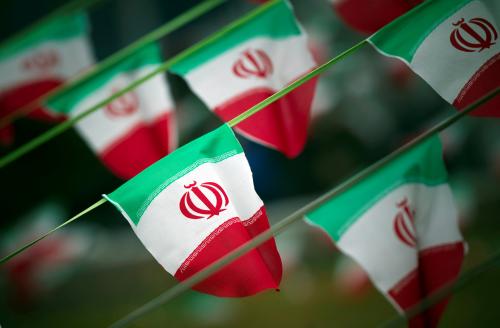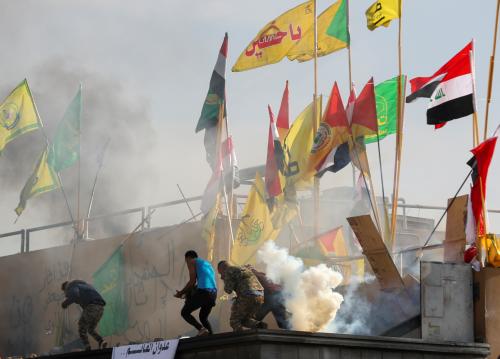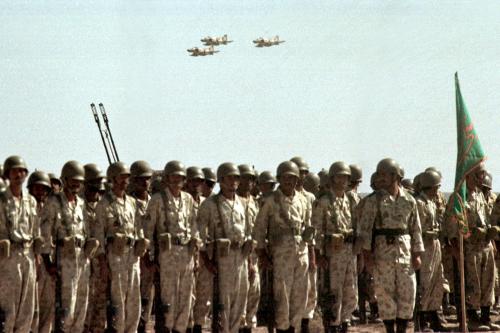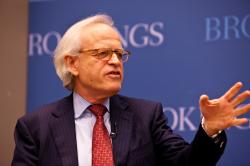On Tuesday, March 28, 2017, Martin Indyk testified before the Senate Foreign Relations Committee on “U.S. strategy toward Iran.” Video of this testimony can be viewed on the U.S. Senate Committee on Foreign Relations website here.
Thank you, Mr. Chairman, for inviting me to address the Senate Foreign Relations Committee today on a matter of considerable import: the bipartisan legislation to counter Iran’s destabilizing activities. As well as imposing sanctions on the IRGC for the organization’s involvement in terrorism, and on individuals involved in Iran’s ballistic missile program, the CIDA legislation also mandates the Administration to:
…develop and submit to the appropriate Congressional committees a strategy for deterring conventional and asymmetric Iranian activities and threats that directly threaten the United States and key allies in the Middle East, North Africa, and beyond.
While the legislation imposes sanctions designed to address the threat posed by Iran’s development of intercontinental ballistic missiles, it clearly seeks to embed that effort in a broader approach that contends with Iran’s destabilizing activities in the Middle East. Developing that strategy is an urgent priority because Iran’s hegemonic ambitions threaten the interests of the United States and its Middle Eastern allies. Through the sponsorship of terrorist organizations like Hezbollah and Palestine Islamic Jihad, the control of Shia militias like the Badr Brigade in Iraq and the Liwa Fatemayoun in Syria (whose troops come from Afghanistan), the deployment of the Iranian Revolutionary Guards Al Qods force, and the provision of missiles and other arms to Houthi rebels in Yemen and other proxies across the region, Iran has gone a long way to achieving its regional ambitions. It has established an “arc of influence” that stretches from Lebanon on the Mediterranean Sea, across Syria in the Middle East heartland, to Iraq and Bahrain on the Gulf, and to Yemen on the Red Sea.
Iran has been assiduously pursuing this effort since the overthrow of the Shah almost four decades ago when it began its unceasing efforts to export its revolution to the Middle East and beyond. In the 1990s, for example, when I had responsibility for Iran policy in the Clinton Administration, we pursued a strategy of containment to deal with the threat that was already manifest. That was part of a two-branch strategy, in which President Clinton sought to advance a comprehensive Arab-Israeli peace as the second branch. The calculation in those days was that the more progress we made in peacemaking, the more effective we would be in containing the Iranian revolution, and the more effectively we isolated Iran, the more progress we would be able to make in advancing peace.
The Iranians, who live in a strategic environment and have practiced the art of strategy since the days of Cyrus the Great, 600 years before the birth of Christ, were successful in countering our approach by systematically undermining our efforts to advance Arab-Israeli peace, using their proxies, Hezbollah, Palestine Islamic Jihad, and Hamas. Had we succeeded in achieving a breakthrough to peace between Israel and Syria in those days, which was actually much closer than the Israeli-Palestinian deal we were also pursuing, the Iranians would have suffered a strategic setback that might well have changed the course of Middle Eastern history.
But that is conjecture. What is not conjecture is the fact that Syria remains the lynchpin of Iran’s strategy for dominating the Middle East heartland. Therefore, any new American strategy to counter Iran’s threats needs to take account of the way that, in the Middle East, everything is connected. Push back on Iran in Yemen, and they might well stir up the Shia population in Bahrain. Push back on Iran in Syria, and they might well use the Shia militias in Iraq to undermine our effort to eliminate ISIS there, or encourage Hamas to launch rocket attacks on Israel from Gaza.
Back in 1996, when the Iranians thought we were making progress in brokering peace between Israel and Syria, they ordered Hezbollah to launch a terrorist attack on the Khobar Towers in Dahran, Saudi Arabia, killing 19 U.S. Air Force personnel. They are quite capable of repeating that exercise today against American troops in Syria or Iraq. As Senator Cotton knows, since he asked the question of General Dunford, the Chairman of the Joint Chiefs of Staff, in his confirmation hearings in 2015, the Iranians may have been responsible for the deaths of as many as 500 American soldiers in Iraq during the Surge, by supplying explosively formed penetrators (EFPs)to Shia militias.1
In short, countering Iran’s regional ambitions is deadly business and we should approach it with the seriousness it deserves. What we need is a comprehensive, integrated and sustainable “push-back” strategy. But in pursuing it, we should be careful about making threats unless we are prepared to back them up, and we should be wary of declaring objectives that we have neither the will nor capacity to achieve. Above all, we should be mindful of the logical consequences of our strategy and think those through before launching on a course that could well have the opposite effect of what we intended. For all these reasons, I applaud the sponsors of the bill and the members of this committee for seeking to deliberate on these weighty matters.
The rigorous enforcement of the Iran nuclear deal is the first element in a push-back strategy. That will likely be unwelcome to some members of this committee, but in my view, it is essential to its success. Whatever the perceived shortcomings of the JCPOA, it has succeeded in creating a vital ten-year window in which the region is not threatened by Iranian nuclear capabilities and the nuclear arms race that they would inevitably trigger. Nothing is easy about countering Iran in the conflict-ridden Middle East, but everything becomes easier if we do not have an Iranian nuclear threat to contend with at the same time.
As long as the Iranians strictly adhere to the agreement, the United States and its regional allies will have gained vital time to develop and implement the other elements of the push-back strategy. That time is essential because the Iranians have entrenched themselves across the region. They will not easily or quickly be extracted, if at all. We will have to be prepared to play a long game and the JCPOA makes that possible.
The second element in the push-back strategy is support for the Iraqi government of Haider al-Abadi and the Iraqi Armed Forces as they campaign to defeat ISIS and regain control of Mosul and the Sunni regions of Iraq. Since the toppling of Saddam Hussein opened the gates of Babylon to Iran, Iraq’s Shia majority has fallen under the heavy influence of Iran. Eliminating that influence is not an achievable or necessary objective given the historic and religious ties between the neighboring Shias of Iraq and Iran. But providing an effective counter-balance to Iran’s influence in Baghdad is eminently achievable since it is welcomed by the current Iraqi government, which was not the case under the previous Maliki government.
For years, that effort has also been hobbled by the unwillingness of Saudi Arabia and the Gulf Arab states to engage meaningfully with the Iraqi government, which they branded as “Persian.” But the recent visit of the Saudi Foreign Minister to Baghdad, and the Saudi effort to engage with the Sunni tribes of Iraq, presages a new approach which needs to be encouraged and sustained.
This will be particularly important, as the elimination of ISIS in Iraq will generate a huge post-conflict reconstruction challenge in Mosul and the other liberated Sunni regions. If Iranian-directed Shia militias fill the vacuum created by the defeat of ISIS, Iran will have achieved one critically important step in establishing a land bridge from Iran through Iraq to Syria and Lebanon. It will also have created the conditions for the eventual return of Sunni jihadist groups like ISIS and its Al Qaeda precursor, perhaps in an even more extreme form, because the Sunnis of Iraq will not accept Shia dominance of their lives. That is why Sunni state support for a major American-led, post-war reconstruction effort is essential.
The third element in the push-back strategy is effective promotion of a political resolution of the civil war in Yemen. The Trump Administration is currently considering stepping up military support for Saudi Arabia and the UAE in their two-year long military campaign in Yemen.2 This makes sense only if it is wedded to a diplomatic strategy for ending the war, which has already caused thousands of civilian casualties and vast human suffering. Otherwise, the United States will be sucked into the Yemen quagmire like so many outside powers before us.
Greater U.S. military engagement also needs to be weighed in the context of the larger regional strategy that this Committee is calling for. Yemen is a low-cost way for Iran to distract the United States and its Gulf Arab allies from the much more strategically consequential challenges in Iraq and Syria. Already, some 50 percent of Saudi Arabia’s military capacity, and a large part of the UAE’s, is devoted to the Yemen conflict, whereas all that Iran is doing to tie them down is to supply the Houthis with military materiel and financial support.
No doubt, gains on the battlefield can impact the dynamics at the negotiating table. In that regard, a successful effort to take control of the Red Sea port of Hodeida, could impact the Houthi calculus and lead to greater seriousness and reasonableness on their part in the negotiations. But American support needs to be conditioned on the pursuit of a political solution by our Saudi allies as well.
The fourth element in the push-back strategy is to reduce Iran’s influence in Syria. This is by far the most difficult and complicated component of the strategy. Developing and implementing it is not helped by loose talk about the unrealistic objective of “pushing Iran out of Syria.” That may well be the desirable end-state but we need to recognize that neither we, nor the Russians, have the will or capacity to achieve it in current circumstances.
Iran has developed a formidable presence on the ground in Syria. With encouragement from Asad’s Alawite-dominated regime, the Iranians have penetrated the institutions of government that remain in Syria. They have also embedded some 25,000 forces in the government-controlled areas of western Syria. Those forces comprise some 5,000 IRGC, Basij and Iranian Army elements that provide the commanders, advisors and trainers of the larger Shia militias; some 3-5,000 highly trained Hizbollah fighters from Lebanon; and some 20,000 Shia militiamen recruited from Afghanistan and Pakistan. These forces are significantly larger than what is left of the Syrian army or the Russian forces now deployed there. They were responsible for the Asad regime’s reconquering of Aleppo and they remain in control of much of the areas in the north-west where they are taking responsibility for the well-being of Syrian citizens there, much as Hezbollah did in southern Lebanon.
The Iranian-controlled presence is bolstered by two factors that must not be ignored in developing the push-back strategy:
- The Iranian-Asad alliance, which was forged by Asad’s father in the 1980s, when Syria was the only Arab state to side with Iran in the decade-long Iraq-Iran war. Since then, Asad’s son has become ever-more dependent on them for his survival, no more so than in the present. Asad will not demand their departure because it will lead to his demise. And Russia will therefore not demand it either because they fear the consequences of the collapse of the Asad regime more than they value any putative partnership with the United States.
- Iran’s “core interest” in retaining a foothold in Syria because it is the lynchpin of its wider hegemonic strategy. If it loses that foothold, it will seriously jeopardize Hezbollah’s control of Lebanon, the crown jewel of Iran’s regional position. That means Iran will mightily resist any effort to force it out of Syria and has considerable ability to do so. The United States has never viewed Syria as a core or vital interest and we therefore do not have the will or interest in deploying the forces necessary to achieve that objective.
Russia does have a long-standing strategic interest in Syria because of its port facilities for the Russian navy and its role as a platform for the projection of Russian influence across the region. Russian and Iranian interests overlap in Syria in their common objective of maintaining the Asad regime in power. But they are also rivals for influence in Damascus, and Asad relishes the opportunity to play them off against each other. Exploiting that rivalry has advantages for an American strategy of reducing Iranian influence in Syria. However, that game has strict upper limits. Russia will not cooperate in the undermining of its own influence in Syria for the sake of a partnership with the United States. It did that in the 1970s, which led to the loss of its presence in Egypt. It will not repeat that mistake. The idea that Russia will force Iran out of Syria is therefore a dangerous fantasy. And the idea that we should pay for such a fantasy by removing the Ukraine sanctions on Russia would constitute strategic malfeasance, given the impact that would have on our allies in Europe, particularly in Eastern Europe.
We should therefore set more modest objectives. We can, for example, press Russia to deny Iran port facilities in Syria. An Iranian-controlled port would enable Iran more easily to ship weapons to Hezbollah. That would severely exacerbate the conflict between Iran and Israel, something Russia has an interest in avoiding. Similarly, we should support Israel’s insistence that Russia press Iran and Hezbollah not to send their forces south to the Golan Heights. That would risk creating one front across southern Lebanon into the Syrian Golan, which would constitute a highly destabilizing threat to our Israeli ally.
Finally, as in Yemen, we should do what we can to promote a political resolution of the Syrian civil war, one that leads eventually but inevitably to Asad’s departure. In that context, we should insist that one requirement of the political settlement should be the departure of all foreign forces. That principle was incorporated into the Taif Agreement, which ended the Lebanese civil war and eventually resulted in the peaceful departure of Syrian forces from Lebanon. Syrians, who do not want Iranian-controlled militias dominating them in a post-conflict era, will welcome inclusion of that principle. And it will provide us with the legitimacy to demand their eventual departure.
The fifth element in the push-back strategy it to concert the capabilities of our regional allies in a regional security framework that can sustain a long-term, burden-sharing effort. The United States is fortunate to have capable regional strategic partners in Israel, Turkey, Saudi Arabia and the Sunni Arab states, that share a common interest in countering Iran’s threatening ambitions. Each, however, has its own strategic perspective. Our NATO ally Turkey, for example, has a strong interest in preventing Iran from establishing a land bridge across northern Iraq to Syria and has moved ground forces into Iraq to block that prospect. But it will not cooperate in any effort that strengthens the Syrian Kurds. Similarly, Egypt sees Iran as a regional competitor but does not want to exacerbate the Sunni-Shia sectarian conflict for fear that it will advantage Sunni extremists. An effective strategy will therefore need to be based on a variable geometry that builds on the common interest of countering Iran while allowing for specific differences that may condition the involvement of some of our regional partners.
Nevertheless, there is a new readiness across the region to work together, despite their differences. For example, Turkey has just normalized relations with Israel; the Gulf States are developing their security relations with Israel; and Egypt’s security cooperation with Israel is unprecedented. It is time to test the readiness of our allies to come together in a regional security arrangement that will allow us all more effectively to coordinate our efforts against Iran.
The sixth element of the push-back strategy is to lay the foundations for negotiations with Iran about its ambitions and behavior in the region. The Iran nuclear deal, notwithstanding its shortcomings, demonstrates that it is possible to reach enforceable agreements with Iran, using sanctions and concerted diplomacy as leverage to achieve our objectives. This sanctions bill, complemented by the five other elements of the push-back strategy, if successfully developed and implemented, provide a basis for engaging Iran in a negotiation that focuses on:
- Iran’s efforts to export its revolution and interfere in the domestic affairs of Arab states across the region
- Iran’s destabilizing regional activities and its sponsorship of terrorism
- Iran’s ICBM program and its nuclear activities after the expiration of the JCPOA.
Negotiations are not a concession to Iran, nor a sign of weakness, as long as they are backed by sanctions and the other elements of the strategy that I have outlined here, and as long as they are fully coordinated with our regional allies. But they represent a way to signal to Iran that we and our regional allies are willing to have a constructive, normalized relationship with it, even recognize its status as a regional power, if it is willing to change its troubling behavior in fundamental ways. Indeed, if the Iranians prove willing to engage in a serious negotiation about these issues, we should even be prepared to signal to them a willingness to consider lifting our bilateral sanctions, i.e. putting a carrot as well as a stick on the table.
Mr. Chairman, it should be clear from this testimony that developing an effective strategy for dealing with the threats posed by Iran is a complicated and difficult challenge. But the dangers of not doing so are clear and present. I applaud the committee for taking on the task.
-
Footnotes
- “Iran Linked to Deaths of 500 U.S. Troops,” Military Times, July 14, 2015. http://www.militarytimes.com/story/military/capitol-hill/2015/07/14/iran-linked-to-deaths-of-500-us-troops-in-iraq-afghanistan/30131097/
- Karen de Young and Missy Ryan, “Trump Administration Weighs Deeper Involvement in Yemen War,” The Washington Post, March 27, 2017. https://www.washingtonpost.com/world/national-security/trump-administration-weighs-deeper-involvement-in-yemen-war/2017/03/26/b81eecd8-0e49-11e7-9d5a-a83e627dc120_story.html?hpid=hp_rhp-top-table-main_usyemen-720pm%3Ahomepage%2Fstory&utm_term=.a313a0a0eb67
The Brookings Institution is committed to quality, independence, and impact.
We are supported by a diverse array of funders. In line with our values and policies, each Brookings publication represents the sole views of its author(s).










Commentary
TestimonyU.S. strategy toward Iran
March 28, 2017